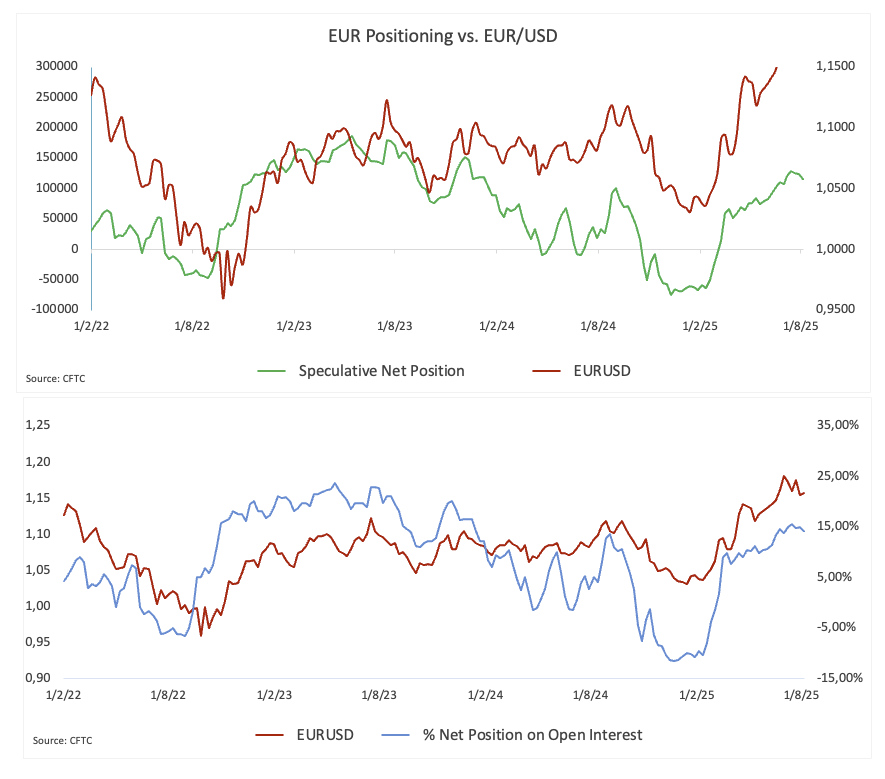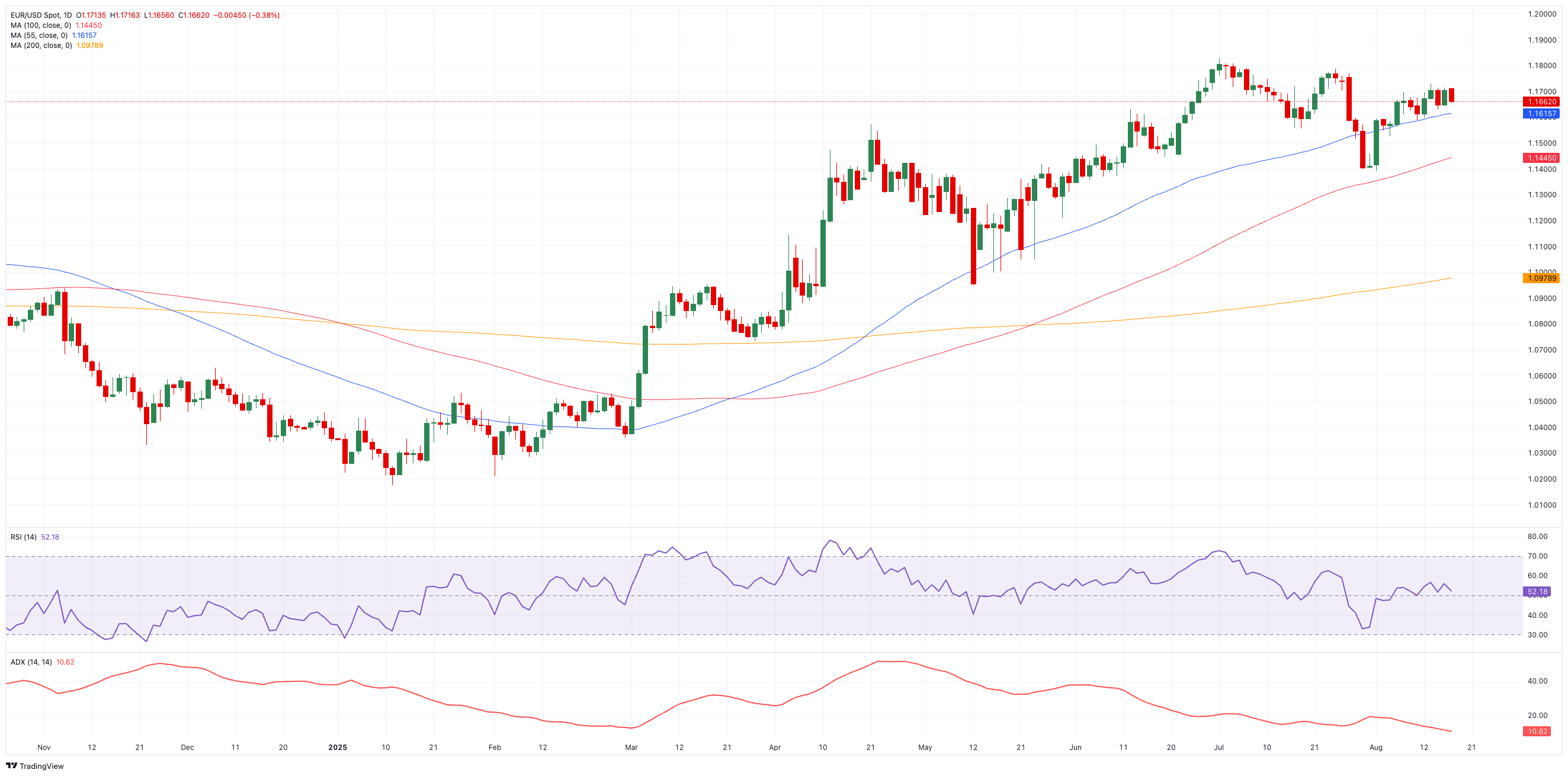
- EUR/USD faced extra downward bias on Monday, returning to the sub-1.1700 zone.
- The US Dollar saw its buying interest renewed in line with rising US yields.
- Markets remain focused on geopolitics ahead of the FOMC Minutes and Jackson Hole.
The Euro (EUR) lost momentum in a negative start to the week, setting aside Friday’s bullish attempt. That said, EUR/USD came under fresh downside pressure and slipped back to the vicinity of 1.1650 on Monday. Despite the knee-jerk, the pair kept navigating its upper end of the monthly range.
Meanwhile, the improved sentiment surrounding the US Dollar (USD) negatively impacted the risk complex and triggered a corrective move in spot prices, as investors remained attentive to the Trump-Zelenskiy meeting and the fragile geopolitical situation. Adding to the broad prudent stance, caution remains in place ahead of the release of the FOMC Minutes (Wednesday) and the speech by Chair Jerome Powell at the Jackson Hole Symposium (Friday).
Trade détente boosts risk mood
In past weeks, markets welcomed a temporary reprieve in global trade tensions. Washington and Beijing agreed to a 90-day extension of their trade truce, just hours before tariff increases were due to take effect. President Trump signed an executive order pushing the deadline out to November 10, with China pledging to reciprocate. Under the deal, existing tariffs remain — 30% on Chinese goods entering the US and 10% on US exports heading the other way.
The announcement followed a US–European Union (EU) trade accord that trimmed most European tariffs on US exports to 15% from a threatened 30%. Crucially, aerospace, semiconductors, and agricultural goods were exempt from new duties, while steel and aluminium remained taxed at 50%. In return, the EU promised $750 billion in US energy purchases, more defence orders, and more than $600 billion in American investments.
The market received mixed reactions: German Chancellor Friedrich Merz cautioned that the deal could weigh on Europe’s already strained manufacturing base, while French President Emmanuel Macron called it a “dark day” for the continent.
Central banks cautious, not committed
The Federal Reserve (Fed) held interest rates steady at its most recent meeting. Chair Jerome Powell struck a measured tone, balancing his remarks against dovish votes from Governors Christopher Waller and Michelle Bowman.
In Frankfurt, European Central Bank (ECB) President Christine Lagarde described eurozone growth as “solid, if a little better.” Markets, however, have pushed back expectations for the first rate cut until spring 2026.
Positioning turns less bullish
Speculators have been pulling back. Commodity Futures Trading Commission (CFTC) data through August 12 showed net long positions in the Euro shrinking to a six-week low near 115.4K contracts. Commercial players, however, increased their net short positions to just over 167K contracts, a two-week high. Open interest rose to around 825K contracts after two consecutive weekly pullbacks.

Technical picture
Resistance is first seen at the July 24 weekly high of 1.1788, followed by the July 1, 2025 ceiling at 1.1830. Beyond that lies the September 3, 2021 peak at 1.1909, just below the psychological 1.2000 barrier.
On the other hand, interim support comes at the 100-day SMA at 1.1451 followed by the August 1 low of 1.1391, and then the May 29 weekly floor at 1.1210.
Additionally, momentum signals remain mixed: The Relative Strength Index (RSI) has eased toward the 52 mark, suggesting fading upside momentum, while the Average Directional Index (ADX) just above 12 continues to point to a weak, colourless market.

Outlook: Dollar remains in the driver’s seat
For now, EUR/USD looks set for consolidation. A clearer directional break may depend on the Fed’s next move or a meaningful easing in global trade tensions. Until then, US Dollar flows are likely to remain the dominant driver.
Euro FAQs
The Euro is the currency for the 19 European Union countries that belong to the Eurozone. It is the second most heavily traded currency in the world behind the US Dollar. In 2022, it accounted for 31% of all foreign exchange transactions, with an average daily turnover of over $2.2 trillion a day. EUR/USD is the most heavily traded currency pair in the world, accounting for an estimated 30% off all transactions, followed by EUR/JPY (4%), EUR/GBP (3%) and EUR/AUD (2%).
The European Central Bank (ECB) in Frankfurt, Germany, is the reserve bank for the Eurozone. The ECB sets interest rates and manages monetary policy. The ECB’s primary mandate is to maintain price stability, which means either controlling inflation or stimulating growth. Its primary tool is the raising or lowering of interest rates. Relatively high interest rates – or the expectation of higher rates – will usually benefit the Euro and vice versa. The ECB Governing Council makes monetary policy decisions at meetings held eight times a year. Decisions are made by heads of the Eurozone national banks and six permanent members, including the President of the ECB, Christine Lagarde.
Eurozone inflation data, measured by the Harmonized Index of Consumer Prices (HICP), is an important econometric for the Euro. If inflation rises more than expected, especially if above the ECB’s 2% target, it obliges the ECB to raise interest rates to bring it back under control. Relatively high interest rates compared to its counterparts will usually benefit the Euro, as it makes the region more attractive as a place for global investors to park their money.
Data releases gauge the health of the economy and can impact on the Euro. Indicators such as GDP, Manufacturing and Services PMIs, employment, and consumer sentiment surveys can all influence the direction of the single currency. A strong economy is good for the Euro. Not only does it attract more foreign investment but it may encourage the ECB to put up interest rates, which will directly strengthen the Euro. Otherwise, if economic data is weak, the Euro is likely to fall. Economic data for the four largest economies in the euro area (Germany, France, Italy and Spain) are especially significant, as they account for 75% of the Eurozone’s economy.
Another significant data release for the Euro is the Trade Balance. This indicator measures the difference between what a country earns from its exports and what it spends on imports over a given period. If a country produces highly sought after exports then its currency will gain in value purely from the extra demand created from foreign buyers seeking to purchase these goods. Therefore, a positive net Trade Balance strengthens a currency and vice versa for a negative balance.
Information on these pages contains forward-looking statements that involve risks and uncertainties. Markets and instruments profiled on this page are for informational purposes only and should not in any way come across as a recommendation to buy or sell in these assets. You should do your own thorough research before making any investment decisions. FXStreet does not in any way guarantee that this information is free from mistakes, errors, or material misstatements. It also does not guarantee that this information is of a timely nature. Investing in Open Markets involves a great deal of risk, including the loss of all or a portion of your investment, as well as emotional distress. All risks, losses and costs associated with investing, including total loss of principal, are your responsibility. The views and opinions expressed in this article are those of the authors and do not necessarily reflect the official policy or position of FXStreet nor its advertisers. The author will not be held responsible for information that is found at the end of links posted on this page.
If not otherwise explicitly mentioned in the body of the article, at the time of writing, the author has no position in any stock mentioned in this article and no business relationship with any company mentioned. The author has not received compensation for writing this article, other than from FXStreet.
FXStreet and the author do not provide personalized recommendations. The author makes no representations as to the accuracy, completeness, or suitability of this information. FXStreet and the author will not be liable for any errors, omissions or any losses, injuries or damages arising from this information and its display or use. Errors and omissions excepted.
The author and FXStreet are not registered investment advisors and nothing in this article is intended to be investment advice.




